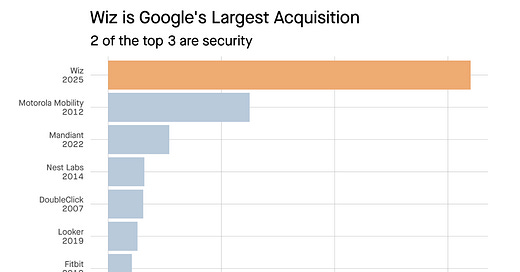👋 Hi, I’m Doug! Welcome to @TheFundCFO crew! Every Tuesday/[Thursday], we publish VC/CFO insights that matter - highlights from notable VC GPs, LPs, and CFOs/finance pros. Check out our VC Fund Playbooks, Models, Budgets, & Compliance Checklists @ AirstreamAlpha Products!
Need more help? Check out Fund CFO Support provided by the Airstream Alpha Team.
Love what we’re doing? Consider upgrading to paid for deeper dives on Thursdays (most paid subscribers expense these insights!).
Top Recent Posts - Check Them Out!
Google Acq Wiz for $32B (Tom Tunguz Recap)
Is tech M&A back? Google announced its intention to buy Wiz for $32b earlier this week. If approved by regulators, it would be the 6th largest technology M&A ever. Wiz is a leading cloud security platform headquartered in New York. Once closed, Wiz will join Google Cloud.
A Game-Changer for VC Investors
The acquisition is a major liquidity event for Wiz’s cap table, benefiting around 25 venture firms that invested in the company. Among them, early investors such as Cyberstarts, Sequoia, and Index are set to realize returns that exemplify the power law in venture capital—where a small number of investments drive the majority of returns.
Cyberstarts, an Israel-based early-stage firm, co-led Wiz’s $21 million seed round in 2020, when the company was valued at approximately $67 million. With just $6.4 million invested from its seed fund, Cyberstarts is poised for a ~$1.3 billion payday, a 200x return in just five years.
Sequoia Capital, which invested $10 million in the seed round and continued participating in later funding rounds, now owns about 10% of Wiz. With the acquisition, Sequoia is expected to cash out around $3 billion.
Index Ventures, Wiz’s largest shareholder with an approximately 12% stake, stands to receive over $3.8 billion.
Late-Stage Investors Also Win Big
While early-stage investors often see the highest multiples, later-stage investors in Wiz are also seeing impressive gains.
Thrive Capital, which led Wiz’s most recent two funding rounds, including one at a $12 billion valuation and another at $16 billion in an employee tender offer, now holds a $1 billion stake. Cyberstarts’ Opportunity Fund, which invested $40 million in 2024, is now set to receive $128 million, a 3x+ return in a short time.
Key Takeaways from Previous Posts
This deal reinforces some key principles we’ve discussed before:
DPI measures how much capital a fund has actually returned to investors. While TVPI includes unrealized gains, DPI reflects real cash returns, making it a critical metric for LPs evaluating fund performance.
Understanding DPI is key to assessing whether a VC fund is truly delivering—not just on paper, but in real returns.
Small VC funds can deliver outsized returns despite higher volatility.
While these numbers reflect solid performance, they also underscore the difficulty of achieving high multiples on large funds. Even with standout exits, the overall fund returns are constrained by sheer fund size and portfolio math.
Carried Interest & DPI Modeling
To make it easy, we want to share more on what DPI really looks (from a real example) including the mechanics for fees & expenses, called capital, carried interest, recycling, and other key components.
Additionally, our tool for managing and analyzing DPI performance can help investors track and optimize their returns more effectively.
Premium VC Tools & Models Below
We’re also offering premium resources tailored for venture capital and finance professionals. Reach out for access!
Keep reading with a 7-day free trial
Subscribe to @TheFundCFO Newsletter to keep reading this post and get 7 days of free access to the full post archives.







